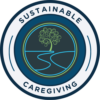According to Family Caregiver Alliance, “Regardless of employment status, unpaid caregivers report that positive activities in their respective daily lives are reduced by 27.2% as a result of their caregiving responsibilities. This effect is three times greater in their personal lives than their professional lives.” Pre-caregiving, I spent hours at the Y and in the woods. I worked, traveled, met friends for meals, and read for pleasure. I didn’t consider these activities self care, just living life. These hobbies reduced stress, but the stress was not unsustainable. Life’s challenges were manageable. They were solvable. They were finite. Resistance to our new reality can prevent us from finding new positive activities.
Two categories of self-care
Mid-caregiving, I redefined self care to have meaning within my new reality. Within the caregiving experience, it is helpful to consider two primary categories of self care. The first category, basic well-being self care, is often neglected when the caregiving experience is new and intense. The second category includes the things that provide restorative self care. Within both categories self care will look different for each person and for each person from day to day, possibly minute to minute.
I may get comfort and clarity from a run in the morning and from sitting motionless in the afternoon. Cooking is my escape most days and then without warning I am desperate to escape the kitchen. I have been able to find peace while attending a concert with friends alongside hundreds of other people and equally in a solitary place in nature. It may be a scent that takes me to a faraway place rather than an actual vacation. Self care now, often comes in moments rather than hours.
Basic well-being
Taking care of our basic well-being requirements can seem impossible when we are suddenly dropped into an intense caregiving experience or have arrived without preparation. We are simply trying to survive. Caregiver depression and anxiety are common. This article, Caregiver Depression: Silent Health Crisis, provides more insight into the relationship between caregiving and depression. Sustainability starts with meeting our basic well-being needs. Here are a few:
- Acceptance and Forgiveness – These skills are like muscles that need to be developed and require frequent training and practice to maintain strength and muscle memory.
- Health – Schedule the wellness visit, the dentist appointment, other appointments that have been neglected because you have placed your health priorities last.
- Talk it out – Locate the option that works for you. Look into online support groups, community support groups, a minister or rabbi, a therapist or counselor.
- Routine – Commit to a morning and evening ritual to ensure that you are not skipping important steps in your own self maintenance.
- For optimal energy
- Choose healthy foods; consider an app to track food and nutrients
- Drink lots of water
- Get as much sleep as possible at night
Move from survive to thrive
Beyond the basics we can get more creative and move from survive to thrive. It may take some inner exploration to identify what sustains you, what rejuvenates and revives your spirit. What do you consider guilty pleasures? What if you removed the guilt? What are your passions? How can you work your restorative self care interests into your daily activities? How can you be mindful when you are in the midst of the restorative experience so that you feel the comfort that your activity brings? Here are a few ideas to spark your imagination and inspire you to achieve moments or more of serenity or adventure. Choose one or two and layer in more as you re-define and re-claim self care.
- Music – Create a “Reset my Mood” playlist or try the Calm app which has a vast selection of music for sleeping, relaxing and more.
- Meditation – The Calm app is my go-to when I need to step away from the intensity. It also has sleep stories that work magic. For ninja level naps, choose a selection from the naps category.
- Breathe – There’s an app for that too. There are also breathing exercises that bring about immediate relaxation in line at the grocery store or after awakening in the middle of the night. My favorite is to inhale slowly through the nose, hold my breath for 5 seconds and release breath through the mouth. Repeat 5 times.
- Move – Run, walk, bike, dance, skate your way to contentment.
- Scents – Find your peace in lotions and essential oils.
- Tea – I love discovering new flavors. Current favorites are Pukka’s Revitalise with cinnamon, cardamom, ginger and more, https://www.pukkaherbs.com and Yerba Mate from Revival Tea Company, https://www.revivalteacompany.com.
- TV – Watch a favorite show while cooking or doing chores.
- Writing – It may be a diary, poetry or gratitude journal. If you enjoy writing, find a beautiful blank book to hold your unique thoughts.
- Nature – If nature is your happy place, make spending time outside a priority. Or, put up a bird feeder and watch the bird channel from the window.
- Pet therapy – Cuddle with your furry friend or any available.
- Treat yourself – Get a coffee or ice cream while running errands.
- Read – Download that book that will offer an escape or allow you to learn about something new. Books offer an amazing opportunity to help us stay curious, get outside of ourselves or dig deeper, go on an adventure or take a class without leaving home.
- Friends – Schedule a lunch or coffee. Focus on reconnecting and catching up. Friends don’t always “get it” when it comes to caregiving stress, so expectations of empathy can be met with disappointment.
- Laugh – Appreciate the humor in those things that you know you will laugh about later. Watch Seinfeld reruns, whatever makes you smile out loud.
- Oasis – Create a comfy corner within your caree’s home so that you have a place to restore and regroup. Imagine LED candles, a special scent, mood music, tea and pillows in your favorite colors.
Navigating the Caregiver River: A Journey to Sustainable Caregiving is available on Amazon. Also, check out the Self-Caregiving Strategies Podcast.
Schedule Theresa Wilbanks to speak on caregiving and empower the caregivers in your workplace or community with the 12 Sustainable Caregiving Strategies.
Advice offered is for general information only; please contact your healthcare team, legal or financial advisors to guide your particular situation.


Pingback: Millennial Caregivers: Burning the Candle at Both Ends - Sustainable Caregiving™
Pingback: Coronavirus Preparation & Prevention Plan - Sustainable Caregiving™
Pingback: Isolation 2.0 - Sustainable Caregiving™
Pingback: Self-Care During COVID-19: Lessons from Family Caregivers - Sustainable Caregiving™
Pingback: My Caregiving Support System Jenga Tower - Sustainable Caregiving™
Pingback: 7 Ways to Support the Family Caregiver - Sustainable Caregiving™
Pingback: 7 Holiday Sustainable Caregiving™ Strategies - Sustainable Caregiving™
Pingback: How Do We Sustain Our Ability to Provide Care? - Sustainable Caregiving